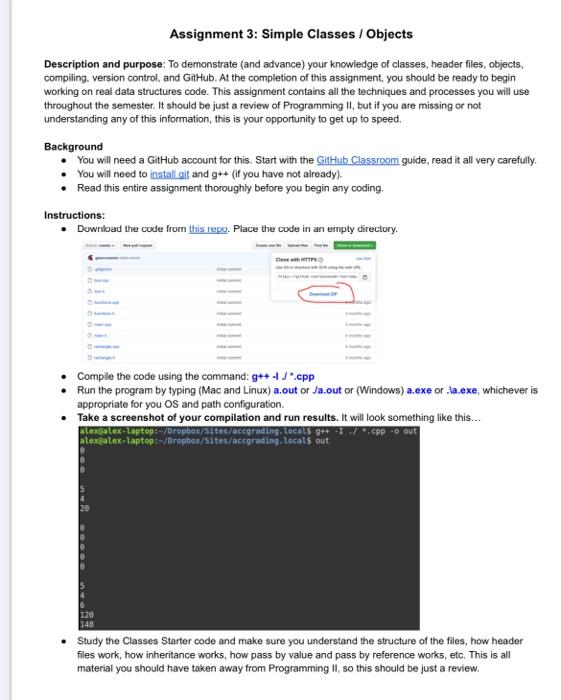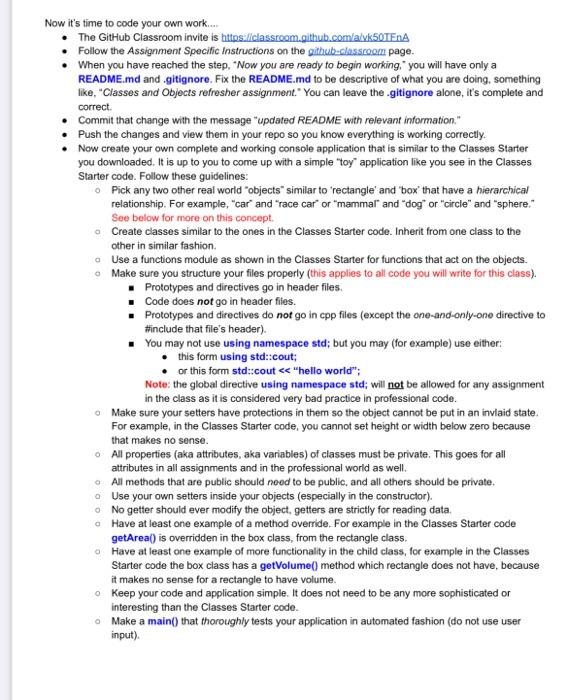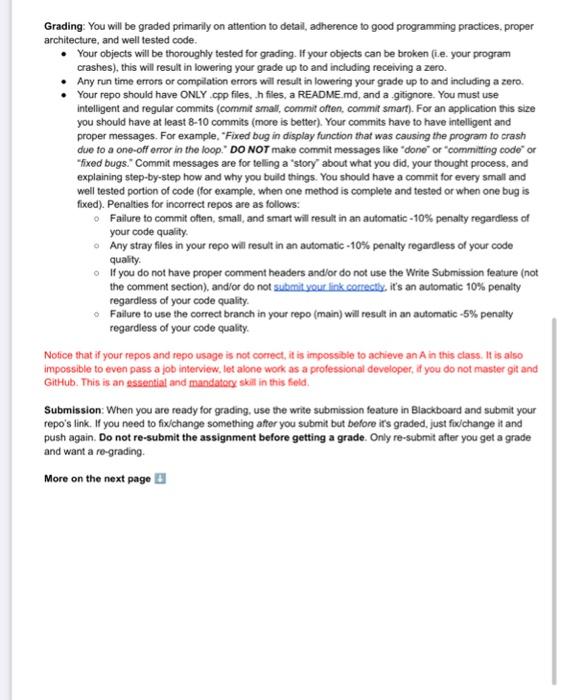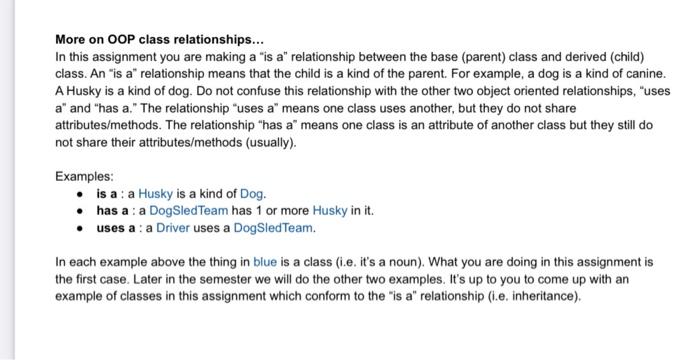Answered step by step
Verified Expert Solution
Question
1 Approved Answer
data structures. i need help understanding this assignment. can someone break down the steps and instructions? Assignment 3: Simple Classes / Objects Description and purpose:
data structures. i need help understanding this assignment. can someone break down the steps and instructions? 



Assignment 3: Simple Classes / Objects Description and purpose: To demonstrate (and advance) your knowledge of classes, header files, objects, compiling. version control, and Github. At the completion of this assignment, you should be ready to begin working on real data structures code. This assignment contains all the techniques and processes you will use throughout the semester. It should be just a review of Programming II, but if you are missing or not understanding any of this information, this is your opportunity to get up to speed. Background - You will need a GitHub account for this. Start with the Github Classroom guide, read it all very carefully. - You will need to install git and g++ (if you have not already). - Read this entire assignment thoroughly before you begin any coding. Instructions: - Download the code from this repo. Place the code in an empty directory. - Comple the code using the command: g+++J.cpp - Run the program by typing (Mac and Linux) a.out or Ja.out or (Windows) a.exe or .la.exe, whichever is appropriate for you OS and path configuration. - Take a screenshot of your compilation and run results. It will look something like this... - Study the Classes Starter code and make sure you understand the structure of the files, how header files work, how inheritance works, how pass by value and pass by reference works, etc. This is all material you should have taken away from Programming II, so this should be just a review. W it's time to code your own work.... - The Github Classroom invite is hitps:liclassroom.github.comlalvk50TEnA - Follow the Assignment Specific Instructions on the github-classcoom page. - When you have reached the step, "Now you are ready to begin working," you will have only a README.md and .gitignore. Fix the README.md to be descriptive of what you are doing. something like, "Classes and Objects refresher assignment." You can leave the -gitignore alone, it's complete and correct. - Commit that change with the message "updated README with relevant information." - Push the changes and view them in your repo so you know everything is working correctly. - Now create your own complete and working console application that is similar to the Classes Starter you downloaded. It is up to you to come up with a simple "toy" application like you see in the Classes Starter code. Follow these guidelines: Pick any two other real world "objects" similar to 'rectangle' and 'box' that have a hierarchical relationship. For example, "car" and "race car" or "mammal" and "dog" or "circle" and "sphere." See below for more on this concept. Create classes similar to the ones in the Classes Starter code. Inherit from one class to the other in similar fashion. Use a functions module as shown in the Classes Starter for functions that act on the objects. Make sure you structure your files properly (this applies to all code you will write for this class). - Prototypes and directives go in header files. - Code does not go in header files. - Prototypes and directives do not go in cpp files (except the one-and-only-one directive to *include that file's header). - You may not use using namespace std; but you may (for example) use either: - this form using std::cout; - or this form std::cout \&e "hello world"; Note: the global directive using namespace std; will not be allowed for any assignment in the class as it is considered very bad practice in professional code. Make sure your setters have protections in them so the object cannot be put in an invlaid state. For example, in the Classes Starter code, you cannot set height or width below zero because that makes no sense. All properties (aka attributes, aka variables) of classes must be private. This goes for all attributes in all assignments and in the professional world as well. All methods that are public should neod to be public, and all others should be private. Use your own setters inside your objects (especially in the constructor). No getter should ever modify the object, getters are strictly for reading data. Have at least one example of a method override. For example in the Classes Starter code getArea() is overridden in the box class, from the rectangle class. Have at least one example of more functionality in the child class, for example in the Classes Starter code the box class has a getVolume() method which rectangle does not have, because it makes no sense for a rectangle to have volume. Keep your code and application simple. It does not need to be any more sophisticated or interesting than the Classes Starter code. Make a main() that thoroughly tests your application in automated fashion (do not use user input). Grading: You will be graded primarily on attention to detail, adherence to good programming practices, proper architecture, and well tested code. - Your objects will be thoroughly tested for grading. If your objects can be broken (i.e. your program crashes), this will result in lowering your grade up to and including receiving a zero. - Any run time errors or compilation errors will result in lowering your grade up to and including a zero. - Your repo should have ONLY .cpp files, h files, a README md, and a gitignore. You must use intelligent and regular commits (commit small, commit often, commit smart). For an application this size you should have at least 810 commits (more is better). Your commits have to have intelligent and proper messages. For example, "Fixed bug in display function that was causing the program to crash due to a one-off error in the loop." DO NOT make commit messages like "done" or "committing code" or "fixed bugs." Commit messages are for telling a "story" about what you did, your thought process, and explaining step-by-step how and why you build things. You should have a commit for every small and well tested portion of code (for example, when one method is complete and tested or when one bug is foced). Penalties for incorrect repos are as follows: Failure to commit often, small, and smart will result in an automatic-10\% penalty regardless of your code quality. Any stray files in your repo will result in an automatic -10\% penalty regardless of your code quality. If you do not have proper comment headers and/or do not use the Write Submission feature (not the comment section), andior do not submit your link comectly, it's an automatic 10% penalty regardless of your code quality. Failure to use the correct branch in your repo (main) will result in an automatic 5% penalty regardless of your code quality. Nofice that if your repos and repo usage is not correct, it is impossible to achieve an A in this class. It is also impossible to even pass a job interview, let alone work as a professional developer, if you do not master git and GitHub. This is an essential and mandatery skill in this feld. Submission: When you are ready for grading, use the write submission feature in Blackboard and submit your repo's link. If you need to fix/change something after you submit but before ir's graded, just foc/change it and push again. Do not re-submit the assignment before getting a grade. Only re-submit after you get a grade and want a ro-grading. More on OOP class relationships... In this assignment you are making a "is a" relationship between the base (parent) class and derived (child) class. An "is a" relationship means that the child is a kind of the parent. For example, a dog is a kind of canine. A Husky is a kind of dog. Do not confuse this relationship with the other two object oriented relationships, "uses a" and "has a." The relationship "uses a" means one class uses another, but they do not share attributes/methods. The relationship "has a" means one class is an attribute of another class but they still do not share their attributes/methods (usually). Examples: - is a : a Husky is a kind of Dog. - has a : a DogSledTeam has 1 or more Husky in it. - uses a : a Driver uses a DogSledTeam. In each example above the thing in blue is a class (i.e. it's a noun). What you are doing in this assignment is the first case. Later in the semester we will do the other two examples. It's up to you to come up with an example of classes in this assignment which conform to the "is a" relationship (i.e. inheritance) 



Step by Step Solution
There are 3 Steps involved in it
Step: 1

Get Instant Access to Expert-Tailored Solutions
See step-by-step solutions with expert insights and AI powered tools for academic success
Step: 2

Step: 3

Ace Your Homework with AI
Get the answers you need in no time with our AI-driven, step-by-step assistance
Get Started


